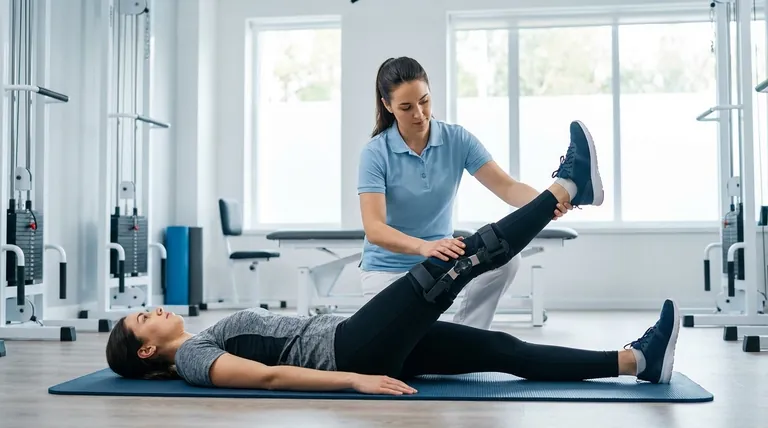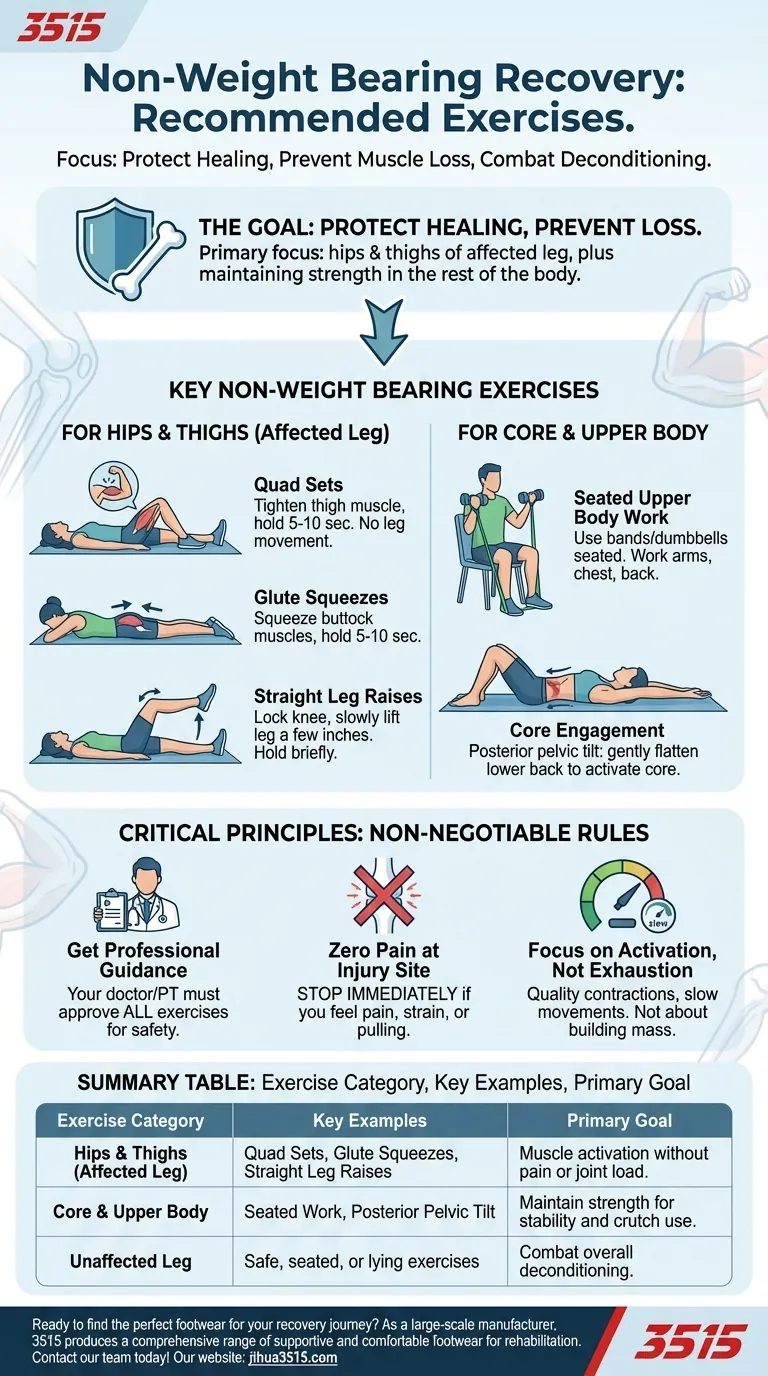During a non-weight bearing recovery, the recommended exercises are those that activate key muscles without placing any load on the healing injury. The primary focus is on the hips and thighs of the affected leg, as well as maintaining strength in the rest of your body to combat the deconditioning that comes from reduced activity.
The core objective of exercise during this phase is not to build new strength, but to intelligently minimize the loss of muscle and conditioning while your body's top priority remains healing the injury.

The Goal: Protect Healing, Prevent Loss
When you are instructed to be non-weight bearing, it means a bone, ligament, or other tissue needs to be completely unloaded to heal properly. Any exercise plan must operate strictly within that boundary.
Why Healing is Priority #1
The non-weight bearing protocol exists for one reason: to create an undisturbed environment for your body to repair itself. Violating this can delay healing or cause further damage. All activity must support this primary goal.
The Problem of Deconditioning
Unfortunately, inactivity has consequences. Muscles that aren't used begin to weaken and shrink (atrophy), and overall cardiovascular fitness declines. This happens not just in the injured leg but throughout the body.
Shifting Focus to the Support System
The solution is to focus on the muscles you can safely work. This includes the large muscles of the hip and thigh on your injured side (without loading the joint), your unaffected leg, your core, and your upper body.
Key Non-Weight Bearing Exercises
These exercises are designed to be performed while lying down or sitting, ensuring no weight is placed through the injured area.
For the Hips and Thighs
These movements isolate muscles to keep them active. They are often the first exercises prescribed by a physical therapist.
- Quad Sets: While lying down with your leg straight, tighten your thigh muscle (quadriceps) and hold for 5-10 seconds. You should feel the muscle engage without moving your leg.
- Glute Squeezes: Lie on your back or stomach and squeeze your buttock muscles together, holding the contraction for 5-10 seconds.
- Straight Leg Raises: Lie on your back, tighten your quad to lock your knee straight, and then slowly lift your entire leg a few inches off the bed. Hold briefly and lower slowly.
For the Core and Upper Body
Maintaining core and upper body strength is crucial, especially if you are using crutches, which place significant demand on your arms, shoulders, and back.
- Seated Upper Body Work: Using light dumbbells or resistance bands while seated securely in a chair allows you to work your arms, chest, and back.
- Core Engagement: Exercises like a posterior pelvic tilt (gently flattening your lower back against the floor while lying down) can activate deep abdominal muscles without stressing the leg.
Understanding the Critical Principles
Success in this phase is less about what you do and more about how you do it. Sticking to these principles is non-negotiable for a safe recovery.
Principle 1: Get Professional Guidance
This information is a guide, not a prescription. Your doctor or physical therapist must approve any exercise. They understand the specifics of your injury and can clear you for what is safe.
Principle 2: Zero Pain at the Injury Site
This is an absolute rule. If you feel any pain, strain, or pulling at your injury site, stop the exercise immediately. The goal is muscle activation, not pushing through pain.
Principle 3: Focus on Activation, Not Exhaustion
The objective is to send a signal to your muscles to prevent them from weakening. It is not about fatiguing the muscle or building new mass. Focus on slow, controlled movements and quality contractions.
Making the Right Choice for Your Recovery
Your approach should be tailored to your specific situation and the guidance you've received from your medical team.
- If your primary focus is maximum protection: Concentrate only on gentle exercises for your upper body and core, and the unaffected leg.
- If your primary focus is minimizing muscle loss: Carefully incorporate approved isometric exercises like quad sets and glute squeezes for the affected leg, ensuring no pain.
- If your primary focus is supporting overall fitness: Create a consistent routine that combines safe upper body, core, and unaffected leg exercises with the specific activation work cleared for your injured limb.
By focusing on what you can safely control, you become an active partner in achieving a stronger and more efficient recovery.
Summary Table:
| Exercise Category | Key Examples | Primary Goal |
|---|---|---|
| Hips & Thighs (Affected Leg) | Quad Sets, Glute Squeezes, Straight Leg Raises | Muscle activation without pain or joint load |
| Core & Upper Body | Seated Work with Bands/Dumbbells, Posterior Pelvic Tilt | Maintain strength for stability and crutch use |
| Unaffected Leg | Safe, seated, or lying exercises | Combat overall deconditioning from inactivity |
Ready to find the perfect footwear for your recovery journey? As a large-scale manufacturer, 3515 produces a comprehensive range of supportive and comfortable footwear for distributors, brand owners, and bulk clients. Our production capabilities encompass all types of shoes and boots, including those ideal for rehabilitation. Let us help you provide the right products for your customers' needs.
Contact our team today to discuss your footwear requirements!
Visual Guide

Related Products
- Wholesale Customizable Suede Safety Boots - Puncture-Proof with Velcro Closure
- Customizable Slip-On Safety Shoes Direct from the Factory for Wholesale
- Durable Military Combat Boots with Water Drainage for Wholesale & OEM
- Wholesale Anti-Smash & Puncture-Proof Safety Shoes Custom Manufacturing for Brands
- Safety Footwear Wholesale Manufacturer for Custom OEM/ODM Production
People Also Ask
- Why is maintenance important for work boots? Protect Your Investment and Safety
- Is it normal to wear shoes in the house? A Guide to Hygiene, Comfort & Culture
- What is the purpose of ASTM International? A Guide to Global Quality Standards
- What are the potential consequences of wearing improperly designed work boots? Avoid Injury & Boost Safety
- What are the cultural perspectives on wearing shoes in the house? A Guide to Home Etiquette & Hygiene



















